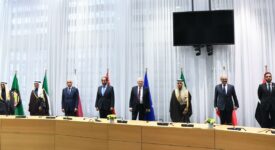When it comes to migration, all eyes are now focused on the central Mediterranean route, which runs primarily from Libya to Italy. Until mid-July, irregular crossings from Libya to Italy were on course to become a record high with more than 200,000 arrivals and a corresponding number of drownings.
At the end of the summer, however, the number of arrivals suddenly fell between a quarter and a third when compared with the numbers recorded before the summer. The reasons for these developments are getting increasingly obvious. The number of people coming into Libya along migration routes from the neighboring countries dropped in 2016 which was also coupled with more assistance from the voluntary return program. There is also some evidence that migrants are increasingly turning towards the Western part of the Mediterranean but most importantly, the fall in the number of arrivals can be attributed to the Memorandum of Understanding (MoU) that Italy signed with the UN-backed Libya government in February of this year. The deal talks about resuming past cooperation between Libya and Italy on issues such as security and migration while also aims at deepening migration policies.
Despite the good intentions, there are reasons that prompt many to reconsider the viability of the cooperation between the EU and Libya. Tracking the money flows from the EU is increasingly difficult, human rights are a constant issue and there are rumors that smugglers turned into coast guard officers overnight. The simple truth is that working with the countries along the migration routes was always an easy choice but never a complex treatment to a very convoluted problem.
Undeniably, Libya is far from an ideal partner. Yet, it is a straightforward partner whose motivations are clear: money and equipment are always useful. And even though the EU is now very vulnerable to mood and power dynamics within Libya’s power structure, it is probable that more money could solve at least some of the future differences. There is also an alternative to the unsustainable situation before summer 2017 but it involves more actors and is therefore more unwieldy. Despite the voluntary return program, most migrants do not want to leave and arriving on EU soil is a de facto a ticket to stay, making public sentiment more and more hostile.
The African countries of origin need to persuade their own citizens to stay at home and they are often unwilling to do so. One reason for this is the fact that the diaspora is an important source of remittances, facilitating trade opportunities. Returning people is also unpopular in the destination countries and therefore there is a push in EU legislation to focus on future migrants rather than on the current ones. The expectation of being repatriated will over time decrease the number of crossings by those migrating for economic purposes. However, this strategy is only applicable if asylum procedures accompanied by all the necessary conditions to protect human rights are done relatively swiftly. Italy will likely continue bearing the brunt of this process and it will therefore need substantial physical and moral support by the European community.
‘Migrants in the Mediterranean: Easy and Difficult Solutions’ – Commentary by Mikkel Barslund – Centre for European Policy Studies (CEPS).
(The Commentary can be downloaded here)






